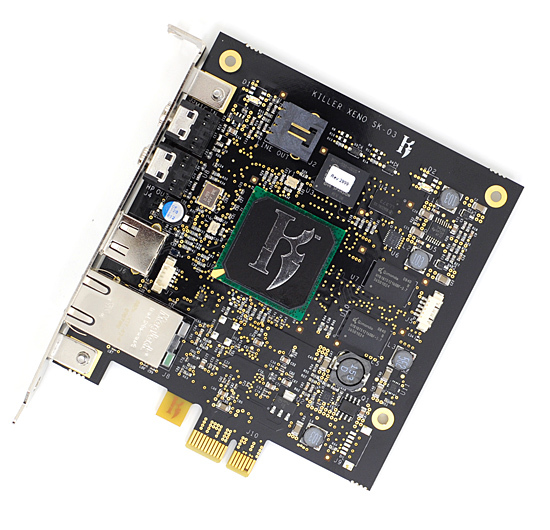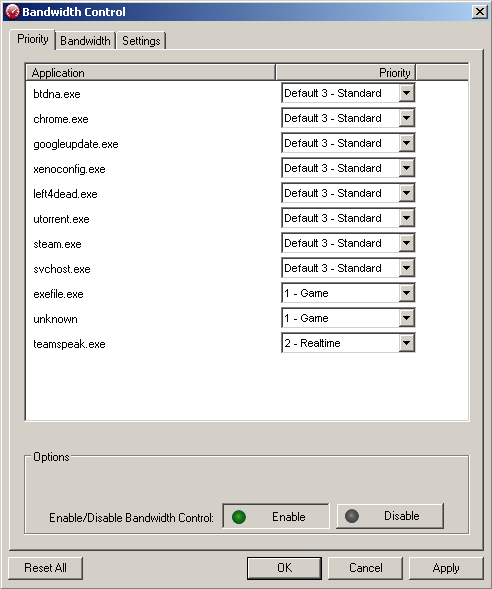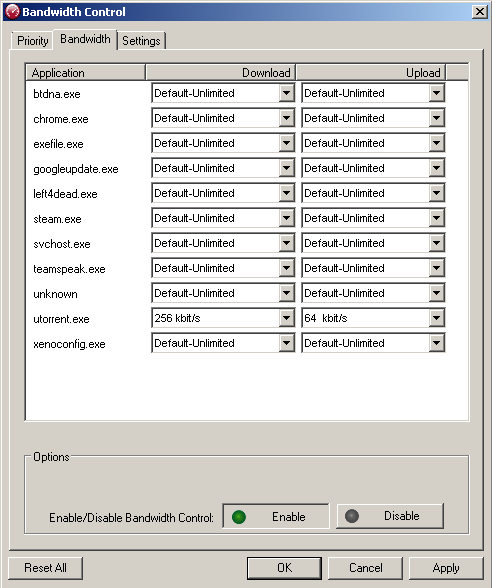EVGA Killer Xeno Pro: The Impact of Network Offloading
by Derek Wilson on July 3, 2009 4:20 AM EST- Posted in
- Networking
The Card and Features
This card sports a 400MHz PowerPC processor with 128MB of RAM, essentially making the Killer Xeno Pro a computer on a x1 PCIe board. As with the first generation, the major feature of the Killer Xeno Pro is it's ability to offload TCP/IP work from the CPU by bypassing the Windows TCP/IP stack.
Microsoft's built-in TCP/IP stack requires the CPU to handle network packet processing. Additionally, when packets arrive, they don't generate interrupts and applications must poll for data (which also wastes time and resources). Bigfoot Networks claims that the windows networking stack is not designed for low latency operation while the Killer Xeno Pro is. Regardless of how (or how efficiently) a software network stack is implemented, having it run in hardware will reduce overhead and impact on the rest of the system. It should also be noted that, for applications which require the windows networking stack (like some VPN products), the Killer Xeno Pro can disable it's "game mode" and enable "application mode" which does disable TCP/IP offload and can increase compatibility in some cases.
Adding to this, the Killer Xeno Pro hardware is capable of offloading other network centric tasks like VoIP, firewalls, and networked storage (though these features are not all fully supported with appropriate software at this point in time).

Installing the hardware is very straight forward, as it's just a simple PCIe card. If you want to use the voice chat features, the only additional need is to connect either the internal or external audio cable. No power is required, and other than that the network port is all that you'll need to worry about. Despite the fact that there is a USB port on the card, it is not used for anything at this point (but Bigfoot has indicated future potential to enable hardware managed USB attached storage).

Mic in and audio line out on a NIC; now that's a first.
The only installation issue we noted is that the driver install, when necessary, will also flash the Killer Xeno Pro hardware. There isn't very much warning about what's going to happen and no confirmation dialog before the start of the flash process. Those who click through install programs quickly without reading them might get themselves into a bit of trouble. There is no way to cancel the flash update once it's started, and while flashing hardware isn't as risky these days, it might be nice if the drivers were a little more clear about what was going to happen.

Easy mode switching.
The hardware comes with drivers and a tray application that are capable of bandwidth throttling and prioritization. Control can be down to a per application basis and maximum download and upload speeds can be specified. Or for benefit without the headache, applications can be prioritized allowing hardware and usage patterns to determine effective bandwidth. Unfortunately, the drivers and applications for the Killer Xeno Pro only run on Microsoft Windows operating systems (XP and Vista flavors). With the gaming focus, this makes sense, but it would still be nice for those who like to dualboot Mac OS X or Linux.

Per application QoS.

Per application bandwidth limits.
With software support, games and voice chat software can completely delegate any VoIP functionality to the Killer Xeno Pro which would handle taking input from the microphone (which plugs straight into the Killer Xeno Pro), compressing the data and sending it out over the network. When a voice packet is received by the Killer Xeno Pro, it decompresses it and sends it straight to the sound card (either via the soundcard's line-in port or an internal cable) bypassing the rest of the system completely. This should help reduce CPU overhead and voice lag caused by sources other than the network or server.
While this is great from a geeky technical standpoint, there isn't a huge amount of overhead on modern CPUs for voice chat software, and the network is by far the largest source of delay. So the actual benefit isn't going to be huge. These issues are the same with hardware firewall, bandwidth control, and all the extras.
The TCP/IP offload capability of the hardware will definitely remove another task from the CPU and operating system. This will free up resources that could be useful for other things, but the real world benefit of this will be very small in most games where the majority of the work is done on the GPU rather than the CPU. Having an NPU (network processing unit, as Bigfoot Networks likes to call it) that handles TCP/IP processing as soon as packets are received and uses hardware interrupts to let a game know that network packets have arrived (rather than requiring polling) can help decrease the latency between when a packet is received by the network card and when a game is able to make use of it, but as with the voice issue the largest delay is inherent in the internet itself and there is only so much benefit that can be had by optimizing the client side.
Not to say that optimizing client side networking is a bad thing: it certainly is not. The real question here is not whether the Killer Xeno Pro does something useful (because it does), the question is whether that useful thing has any significant impact on experience (and if that impact is high enough to justify the price).










121 Comments
View All Comments
MrHorizontal - Friday, July 3, 2009 - link
Could you pit the Bigfoot NIC's against some other NICs.I'd like to know what the difference between using a 'Server Adapter' such as the Intel PRO/1000 PT Dual port would be (on a LACP compatible switch, even a cheapo one like the Netgear GS108T) for example, or even a direct comparison with the single port Intel PT card, since they all do a lot of TCP offloading work, though not the entire stack like the Bigfoot seemingly does...
I do give a LOT of attention to my network connection being a very keen MMORPGer, so I'd genuinely like to know what I can do end-to-end beyond just having a good ISP to make my network as good as it can be with a fairly reasonable eye on cost (ie not forking out for f5 and Cisco kit!)
DerekWilson - Friday, July 3, 2009 - link
The Killer isn't targeted as competition to server NICs, some of which do a lot more like 10GbE and have specific optimization for handling massive numbers of VMs all trying to use the network at once ... Even server NICs like the Intel ones you point out -- even if they did do full network stack offloading -- are very likely not going to be of any more benefit to gamers than the Killer Xeno Pro.But there is no replacement for testing.
It is something we will keep in mind, but with the limited usefulness the Killer Xeno Pro shows it's sort of hard to justify putting a lot more time and energy into this sort of investigation. I'd like to satisfy my own curiosity on the subject, so maybe it will be something we get up ... but no promises. :-)
MrHorizontal - Monday, July 6, 2009 - link
The Killer may not be targetted to server NICs, but as I and a lot of the other comments have noted the price point of the Killer is equal to that of a server adapter. As for whether or not the stack offloading in the Killer NIC and the TCP/IP Offload Engine in the Server Adapters are different and perform differently, only benchmarking both cards would actually provide a good and honest result.I'd like to see ping tests and iperf results using both cards, with and without jumbo frames, using Link aggregation where possible (LACP is effectively SLI for a network card after all) and a comparison with the best and worst mobo adapters versus the Intel / Netgear 'desktop' NICs and the Intel server NIC's versus the Killer NIC.
Essentially what I'm asking from Anandtech is to find what kit we need to get and what configuration changes we need to make to the registry, routers and switches to get absolutely rocking performance from our LANs... which are after all one thing we can control and where a significant amount of lag originates over and above the latency in the ISP's network.
That would be a useful article of the quality that I'd expect from Anandtech. Harping on about a product that noone including yourselves really believes has a market isn't a good report...
UnclePauly - Friday, July 3, 2009 - link
WOW! COUNT ME IN FOR TWO!Myg - Friday, July 3, 2009 - link
This article started with the best of intentions, but fell flat on its face when it came to real value (just like the card apparently).You can't expect a network card to increase FPS (we all know thats just a marketing ploy) and you lot know better and should be able to see through that.
This is a networking device, so it should be treated like one. A suite of dedicated server programs should of been used for the testing. It is terribly lazy of anandtech and seemingly a growing trend to not bother with going that extra mile (which made you guys popular in the first place).
mesiah - Saturday, July 4, 2009 - link
They are testing it for what its marketed towards. The manufacturer makes clear claims in their marketing and this review tested those claims. While it may have some value as a server card, that is not what it was designed for and marketed for. Corvettes have a shitload of power, but whens the last time motor trend talked up their towing capacity? Its beyond the scope of the article.HotdogIT - Friday, July 3, 2009 - link
Why would they test it as a "networking device", when it's clearly being markteted to gamers? The manufacturer themselves claim ping improvements and FPS improvements in GAMES, so not testing GAMES is silly.Every site who has tested this product, HardOCP, Anandtech, TomsHardware, have come to the same conclusion: It's a 125$ NIC, that's better spent on other components. It either has no impact in gaming, or so minimal that it's within the realm of just dumb luck.
The only benefit it might have is throttling of network connections, be it torrents (which you can throttle manually, unless you're an idiot) or downloads (Firefox has a plugin to throttle, and I'm sure it can be done with IE, somehow).
hooflung - Friday, July 3, 2009 - link
In fact, it doesn't do TCP/IP offloading the way you think. It does UDP offloading. That is why your EVE test is flawed. EVE uses a TCP not UDP because it needs a guaranteed connection. The Xeno and original Killer claim WoW FPS goes up, specifically in Really overworked zones, because it offloads that UDP to the NPU.So thanks for your totally crap review filled with misinformation.
DerekWilson - Friday, July 3, 2009 - link
Actually, bigfoot makes it very clear that it's the whole network stack that is offloaded. this includes TCP and UDP. which is also why it has a separate mode for applications that expect a dedicated software network stack.In fact, the WoW example is important, as they told us that WoW uses TCP and NOT UDP -- thus it was not specifically detected as a "game" application (it's the "unknown" blip in the bandwidth control pages).
The Killer Xeno is definitely able to offload TCP because, as we showed, it reduced WoW latency (and potentially could benefit overall performance in heavily populated areas).
I'm not sure whether EVE uses TCP or UDP, but it doesn't matter -- the Killer Xeno Pro should handle both just fine.
hooflung - Friday, July 3, 2009 - link
Funny that, since I have played EVE Online for nearly 6 years and also have had a killer NIC since they came out.I have talked to their engineers and they told me that the Driver does not do TCP accelleration unlike UDP. Also, WoW uses UDP unless the WoW developers are wrong, which I doubt, and the Bigfoot engineer I talked to, aka the guy who designed it who also put a few hundred million into Intel's pocket by creating the offload engine for the Intel Server NIC's is wrong.
I'll just assume you got your facts mixed up. Also, EVE absolutely uses TCP. If you for a single moment loose your TCP connection you will disconnect. You don't from WoW... because they use UDP after you handshake and authenticate to their login server.